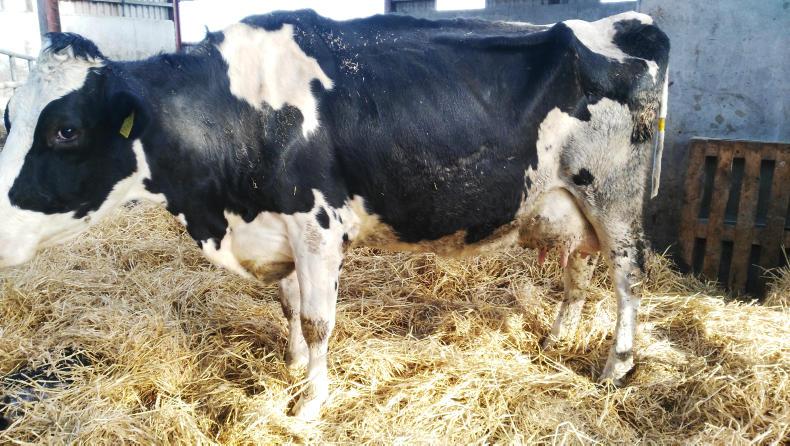We talked to five dairy vets this week in counties Limerick, Waterford, Tipperary, Cork and Kerry. The message was the same from all of the vets – they are all seeing more milk fever on dairy farms. A number of the vets talked about better-quality feed resulting in fat cows and hence more milk fever cases. Are they right?
The period just prior to calving and the week or two after calving is the prime time for milk fever in dairy cows. Cows’ appetite and needs are changing during this time. Subclinical hypocalcaemia (cows will not go down but have low blood calcium) and milk fever (clinical hypocalcaemia) are associated with an increased risk of retained placentas, ketosis, displaced abomasum, prolonged calving and calves slow to suck.
Milk fever results in a severe and rapid drop in the cow’s blood calcium level.
This is because the huge amount of calcium needed for colostrum and milk causes a severe and rapid drop in the cow’s blood calcium level.
When the circulating blood calcium level drops normally, then vitamin D stimulates the bones to deliver more calcium into the circulation. However, if this doesn’t happen or not quickly enough, then the cow’s circulation runs short of calcium.
When you have one case of milk fever in a herd, there is the possibility that other cows have low blood calcium. Remember calcium affects all muscles in the body. It affects the muscles of the heart, the rumen and gut, the muscles of the mammary gland, rumen, rectum, etc. The first sign to most farmers is when the muscles in the legs are not functioning properly and the cow staggers slightly or goes down.
In terms of managing milk fever the key points are:
Body condition score
Dairy cows that are too fat (BCS > 4) in the late dry period eat less immediately pre-calving compared to cows with a lower condition score and this makes them more prone to the diseases mentioned above. In the same way, very thin cows will have reduced milk and can be harder to get back in-calf. The optimum body condition score at calving is between three and 3.5. In particular, watch out for late calvers as these cows are most likely to get over-conditioned. Restrict their feed intake if necessary.
Calcium and magnesium
If you see an increased incidence of milk fever, it may suggest there may be a calcium problem in the transition cows. Adequate level of magnesium in the dry cow diet is also very important. Cows should be on a low-calcium, high-magnesium diet pre-calving. Some farmers give cows a calcium bolus immediately before or after calving to boost calcium levels and prevent milk fever.
Discuss with your adviser/vet if you are giving enough magnesium; you must consider how much magnesium is in your silage and in the dry cow minerals you are using. Most dairy cows will need to be getting 40g of magnesium per day for the three weeks prior to calving.
Cal mag
Remember, if you are feeding calcined magnesite (cal mag), this has only 60% magnesium. In Greenfield Kilkenny in the days following calving, Tom feeds cal mag on top of nuts to freshly calved cows.
Potassium in silage
Some suggest the potassium (K) concentration in silage fed to cows before calving has a significant effect on the incidence of milk fever. Over the last number of years, a greater focus on soil fertility has seen farmers spread more potassium on silage fields to optimise growth.
There has also been a bigger focus on using slurry on low-potassium fields. If you spread a lot of slurry on your silage ground, you could have high potassium in your silage.
Cutting stage and season also have an effect on silage potassium content, with higher leaf content and earlier cutting tending to increase K levels. High-potash silage with K levels >2.5% may be unsuitable to feed cows in the last two to three weeks of pregnancy and instead should be targeted at other groups of stock.
Stock type
Generally, it is older and higher-yielding cows that are at more risk.
Treatment
Milk fever is treated by giving calcium (usually with added magnesium) either intravenously or subcutaneously. If giving it under the skin, the best place to give the calcium is about 5in down from the spine and behind the shoulder blade.
My vet is strong on ensuring the needle is just under the skin first and not too far in. The calcium should flow in freely and soon a bulge will appear under the skin. This will fade away as it disperses and you can help this by pushing it with the hand backwards and upwards under the skin. For the calcium to be absorbed into the bloodstream, it must be completely dispersed so there should be no swelling whatsoever obvious anywhere. When dispersed over a wide area, the cow will have a much better response to the treatment.






 This is a subscriber-only article
This is a subscriber-only article









SHARING OPTIONS: